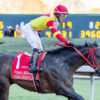Not everybody has the budget for a flashy warmblood to prance around the dressage arena or a gutsy four-star eventing horse to charge around a cross-country course. Some people have only the budget for a sturdy pony, or perhaps, a thoroughbred that’s ready to retire from the track.
The thoroughbred is a fantastically versatile breed, that can turn its courageous and athletic hoof to many different pursuits. However, the off-track thoroughbred, or OTTB, isn’t without its challenges. We’re going to look at the best way to mitigate some of those challenges and ensure that your OTTB has the best introduction possible to leisure riding.

Preakness Stakes 2023 Betting Bible
Get the Racing Dudes’ 2023 Preakness Stakes Betting Bible, featuring the EXACT race-by-race wagering plans for Aaron Halterman and Jared Welch, the two founders of RacingDudes.com. See how they’re playing every race on on May 20, 2023 at Pimlico!
Choosing The Right Horse
The most important step that you can take when it comes to turning an OTTB into a riding partner is picking the correct horse. Some horses can make the change quite easily and others struggle with the transition.
There’s something alluring about having a horse that’s run in a major race and with the Kentucky Derby around the corner, there might be a few runners who don’t make the cut in the coming years. It’s tough to remain at the upper echelons of flat racing and whilst the winners will have lengthy racing and then breeding careers, the horses who don’t do so well might be looking to turn their hoof to a new discipline. However, if next year any of the short-priced runners for this year’s derby on Bodog come up for sale at your local auction, then consider your options very carefully. Horses that have run at a high level on the flat at a young age can run into problems later down the line. You’re far better off selecting a lightly raced horse that didn’t exceed at its job, as it’s much easier to retrain a horse that isn’t to set in its ways.
Starting On The Ground
Once you’ve found your horse and brought it home, it’s time to begin retraining. Start off by leaving your horse well alone for the first couple of weeks. Bring them into the stables, out to the field, and get them used to grooming and being lightly handled, but other than that, just let them settle in.
After a couple of weeks, your horse will have had sufficient time to settle in and begin to feel at home. It’s now that you can begin some groundwork. A lot of racehorses will never have been on a lunge line before, so introducing them slowly to this is essential. Make sure that your commands are clear, both in your body position, how you feel on the reins, and also verbally. A strong woah command will save you endless trouble later on.
Building Foundations
With lungeing or long-lining going well and your horse beginning to trust and respect you on the ground, it’s time to hop aboard. The good news is that your horse is broken in already, so you’re unlikely to receive an explosive negative reaction when you climb into the saddle. However, the controls might not work quite how you’re used to.
A good example of this is the way that racehorses are taught to lean into pressure, rather than yield to it as Western-broke horses are. When a jockey is happy at the gallop speed of the horse, they’ll bridge their reigns and rest them against the horse’s neck, allowing the horse to pull gently against them with its movement.
When the jockey wants the horse to pick up the pace, they’ll remove any slack from the reigns and urge them forward with leg aids. This is a place where many riders can come unstuck when retraining their OTTB, as they’ll pull the reigns to slow down and be met with the opposite reaction. This is where that strong ‘woah’ command that you’ve been practising on the lunge line comes in!
Working on Transitions
Once you’re happy in the saddle and your woah command has made the leap from lunge line to on board, it’s time to move up a few gears. Getting the horse to respond to a trot command and then slow back to a walk is the next building block in your foundations. Using your voice at first, combined with gentle aids and remembering to immediately release pressure when you get the result is the key here.
Ask gently with your legs and voice for a trot, and as soon as the horse complies, remove pressure on the reins and from your legs. To return to walk, sit deep in the saddle, use your ‘woah’ command, and squeeze gently on the reins. As soon as the horse slows to a walk, sit lighter in the saddle, release the tension on the reins, and remember to praise. Spending just ten minutes getting some good transitions and giving out lots of praise is far more valuable than spending hours in the saddle battling it out.
Confidence Building
With your leg, voice and rein aids all being listened to, you might be tempted to get into the competition ring and go for it, but there’s still a little work to do yet. The mantra for taking a horse off the track and retraining is very simple, do it slowly. OTTBs are at a slight advantage when it comes to bomb-proofing because they have already been exposed to a lot of things that other young horses might not have been.
Whilst spooky white railings and starting stalls won’t be a part of their life any more, the basics of trusting humans in slightly scary situations should have been well installed. Work with getting them used to traffic, the sites, and sounds of your surroundings and before long, you’ll have a riding partner who’s worth every bit as much as one of those fancy warmbloods.











